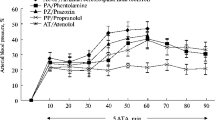Summary
Tetanus toxicity was induced in dogs by injecting the toxin subcutaneously in the groin. On developing generalised toxic symptoms, these dogs were characterised by signs of increased sympathetic discharge to the cardiovascular system as evidenced by high basal values of blood pressure, heart rate and LV dP/dt max. Mild to moderate hypoxia induced by ventilation with 10% O2 in N2 had no appreciable effect on the cardiovascular variables. However, moderate to severc hypoxia induced by ventilation with 7% O2 in N2 further increased the sympathetic discharge to the heart and blood vessels resulting in increases in heart rate, LV dP/dt max and blood pressure. These responses were abolished by adrenergic blockers. The responses in the tetanus dogs were identical to those seen in dogs without tetanus toxicity. Atropine or moderate lactic acidaemia did not alter the responses to hypoxia. Beta-adrenergic blockers appear to be useful drugs in the control of tetanus patients who show evidence of increased sympathetic activity or who develop hypoxaemia.
Similar content being viewed by others
References
Achtel RA, Downing SE (1972) Ventricular responses to hypoxaemia following chemoreceptor denervation and adrenalectomy. Am Heart J 84:377–386
Alfred EE, James OF (1974) Measurement of cardiac pre-ejection period as a guide to the therapy of sympathetic overactivity in tetanus. Anaesthesiol Intensiv Care 2:251–255
Ardill BL, Fentem PH, Wellard MJ (1967) An electromagnetic pressure generator for testing the frequency response of transducers and catheter systems. J Physiol (London) 192:19P-21P
Cheah PS, Mah PK, Feng PH (1972) Severe tetanus successfully treated with high dose of diazepam (Valium) and propranolol. A case report. Singapore Med J 13:163–165
Corbett JL, Kerr JH, Prys-Roberts C, Crampton Smith A, Spalding JMK (1969) Cardiovascular disturbances in severe tetanus due to overactivity of the sympathetic nervous system. Anaesthesia 24:198–212
Detar R, Bohr DF (1968) Oxygen and vascular smooth muscle contraction. Am J Physiol 214:241–244
Downing SE, Talner NS, Gardner TH (1966) Influences of hypoxaemia and acidaemia on left ventricular function. Am J Physiol 210:1327–1334
Edmondson RA, Flowers MW (1979) Intensive care in tetanus management, complications and mortality in 100 cases. Br Med J 1:1401–1404
Elegbeleye OO (1978) Effect of muscle spasms on blood gases and acid-base status in tetanus patients. Eur J Clin Invest 8:423–424
Femi-Pearse D (1974) Blood gas tensions, acid-base status and spirometry in tetanus. Am Rev Resp Dis 110:390–394
Furnival CM, Linden RS, Snow HM (1970) Inotropic changes in the left ventricle: the effect of changes in heart rate, aortic pressure and enddiastolic pressure. J Physiol (London) 211:359–387
Heistad DD, Abboud FM (1980) Circulatory adjustments to hypoxia. Circulation 61:463–470
Hellstrand F, Johansson B, Norberg K (1977) Mechanical, electrical and biochemical effects of hypoxia and substrate removal on spontaneously active vascular smooth muscle. Acta Physiol Scand 100:69–83
Hollow VM, Clarke GM (1975) Autonomic manifestations of tetanus. Anaesthesiol Intensiv Care 3:142–147
Kerr JH, Corbett JL, Prys-Roberts C, Crampton Smith A, Spalding JMK (1968) Involvement of the sympathetic nervous system in tetanus. Lancet II:236–241
Kransey JA, Koehler RC (1977) Influence of arterial hypoxia on cardiac and coronary dynamics in the conscious sino-aortic denervated dog. J Appl Physiol 43:1012–1018
Linden RJ, Norman J (1969) The effect of acidaemia on the response to stimulation of autonomic nerves to the heart. J Physiol (London) 200:51–71
Odusote KA, Sofola OA (1976) Haemodynamic changes during experimental tetanus toxicity in dogs. Naunyn-Schmiedeberg's Arch Pharmacol 295:159–164
Pirzada FA, Hood WB, Messer JV, Bing OHL (1975) Effects of hypoxia; cyanide, and ischaemia on myocardial contraction: observations in isolated muscle and intact heart. Cardiovasc Res 9:38–46
Wallace AG, Skinner NS, Mitchell JH (1963) Haemodynamic determinants of the maximal rate of rise of left ventricular pressure. Am J Physiol 205:30–36
Author information
Authors and Affiliations
Rights and permissions
About this article
Cite this article
Sofola, O.A., Odusote, K.A. The effects of induced hypoxia on the cardiovascular system in dogs poisoned with tetanus toxin. Naunyn-Schmiedeberg's Arch. Pharmacol. 318, 220–224 (1982). https://doi.org/10.1007/BF00500483
Received:
Accepted:
Issue Date:
DOI: https://doi.org/10.1007/BF00500483



